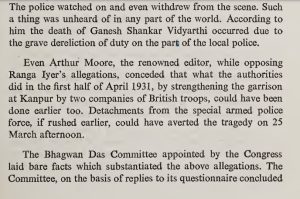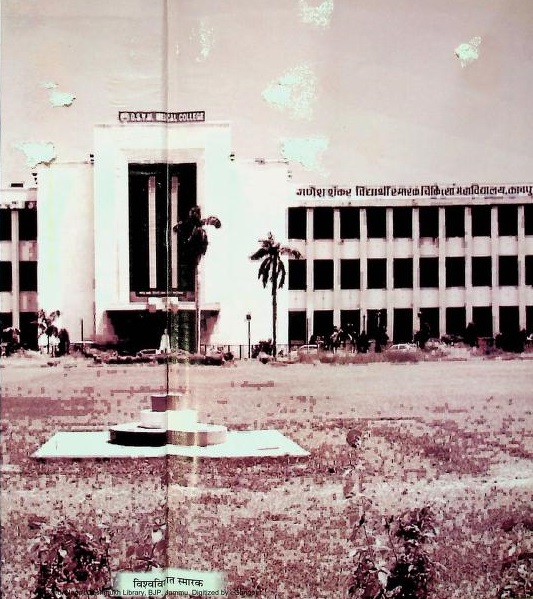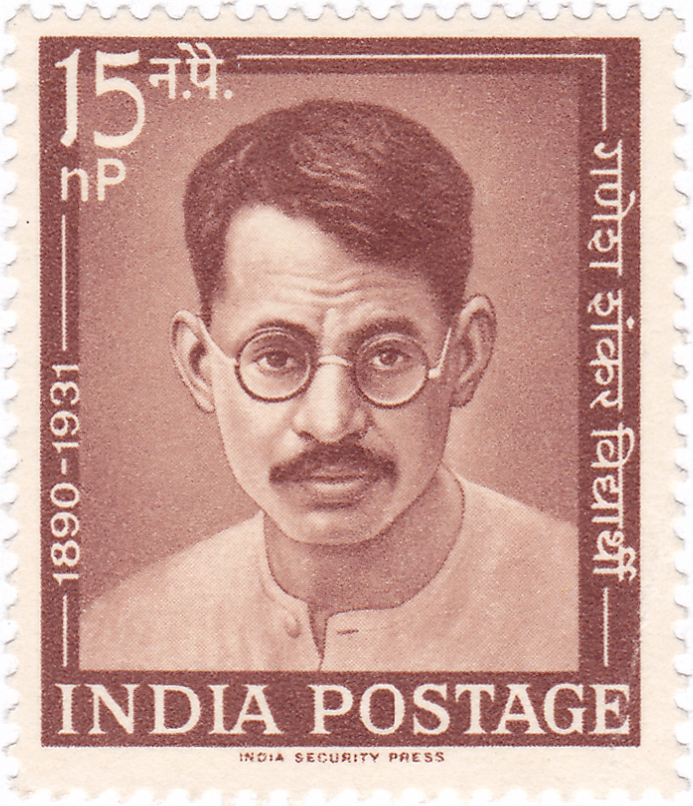Ganesh Shankar Vidyarthi: Luminary of Freedom Movement
Ganesh Shankar Vidyarthi, born 26 October 1890 in Pratapgarh, Uttar Pradesh, was not just a name but an inspiration in the annals of India’s struggle for independence. He was a multifaceted personality: a freedom fighter, journalist, writer, and politician, who left an indelible mark on the nationalist movement with his unwavering commitment to truth, justice, and the Indian Nationalist cause.
Early Life and Education:
Born into a Hindu Kayastha family in Hathgaon, Fatehpur District, Ganesh Shankar’s early life was shaped by the teachings and high ideals of his father, Jai Narain. Jai Narain, alternately known as Jainarayan, taught at the Anglo Vernacular School in Mungaoli, presently a part of the Ashoknagar district in Madhya Pradesh. Despite their modest means, Jai Narain ensured that Ganesh Shankar received a proper education. Ganesh Shankar completed his high school privately in 1907, studying in both Mungaoli and Vidisha. Financial constraints prevented him from pursuing further education, leading him to take up a clerical position at the currency office and later a teaching role in a high school in Kanpur. At a young age of 16, he penned his inaugural book, “Hamari Atmogsargart,” and a couple of years later, in 1909, he married Chandraprakashwati Vidyarthi.
Journalistic Endeavors of Ganesh Shankar Vidyarthi:
His journalistic endeavors were not limited to the written word. He believed in on-ground activism. Whenever there was a protest or a movement, Vidyarthi was present, chronicling events, rallying the masses, and often placing himself in harm’s way to report the truth.
His collection of poems is here for download.
Freedom Movement Participation:
Ganesh Shankar Vidyarthi’s active involvement in the freedom movement was a catalyst for pivotal strategies that galvanized the masses. His participation brought forth grassroots mobilization techniques, which were critical in the Non-Cooperation and Civil Disobedience Movements. His ability to articulate the struggles of the common man and translate them into actionable agendas influenced the Congress’s tactical decisions, leading to more inclusive and widespread protests. Vidyarthi’s frontline presence not only inspired individual acts of defiance but also shaped collective actions that ultimately pressured the British Raj into concessions, although often not to the extent that the freedom fighters hoped for.
As a figurehead in the freedom struggle, Ganesh Shankar Vidyarthi didn’t just participate; he led with compelling stories of resistance that echoed through the ranks of the Indian populace. His editorials in “Pratap” resonated deeply, turning the abstract ideals of freedom into relatable narratives that spurred individuals to action. By emphasizing the injustices faced by Indians under colonial rule, Vidyarthi instilled a sense of urgency and unity amongst diverse groups, effectively bridging gaps between various social strata and reinforcing the movement’s foundation with a shared sense of purpose and identity.
Tragic Death of Ganesh Shankar Vidyarthi
Ganesh Shankar Vidyarthi’s untimely death was not just a personal tragedy but a significant blow to the ethos of communal harmony that he staunchly advocated. His efforts to diffuse communal tensions had a profound influence on both local and national politics, as he embodied the Congress party’s secular stance. His work and ultimate sacrifice deeply affected his contemporaries, including leaders like Mahatma Gandhi, who frequently cited Vidyarthi’s dedication to unity as exemplary. The loss of such a conciliatory figure during a time of increasing communal unrest underscored the urgency for independence and the need for inclusivity in the political discourse of the time.
On 25 March 1931, communal tensions escalated into riots in Kanpur. Although Vidyarthi had plans to attend the Karachi Congress Session, he prioritized aiding the affected residents, ultimately sacrificing his life in the process. Eyewitnesses recall him saving individuals from both Hindu and Muslim communities.
Conspiracy About Ganesh Shankar Vidyarthi’s Death:
His daughter relayed that after rescuing some Muslim women, Vidyarthi was attacked while attempting to save people. She also posited that the colonial regime might have had a role in orchestrating his murder.
Days later, Vidyarthi’s mutilated body, bearing multiple stab wounds, was discovered. Senior journalist from Fatehpur, Premshankar Awasthi, opined that Vidyarthi’s sacrifice for communal harmony established him as a beacon of Hindu-Muslim unity that Muslims never desired.
His death was a testament to the defective policies of Congress.
Ganesh Shankar Vidyarthi was a beacon of hope, courage, and resilience during India’s freedom struggle. His life was cut short by the defective policies of Congress and bad intentions of British Raj.
Analysis on Conspiracy Theorey
Delving into the intricate layers of historical narratives often reveals alternate perspectives and contested interpretations. In the section ‘Analysis on Conspiracy Theory’, we explore the contentious viewpoints surrounding the untimely demise of Ganesh Shankar Vidyarthi. Dr. M.L. Bhargava’s insights in his book “Builders of Modern India: Ganesh Shankar Vidyarthi” provide a critical examination of the events that led to a tragedy which many believe could have been prevented
Dr ML Bhargava, in his book: Builders of Modern India Fanesh Shankar Vidyarthi, says (Page 164)
Quote
“Even Arthur Moore, the renowned editor, while opposing Ranga Iyer’s allegations, conceded that what the authorities did in the first half of April 1931, by strengthening the garrison at Kanpur by two companies of British troops, could have been done earher too. Detachments from the special armed police force, if rushed earlier, could have averted the tragedy on 25 March afternoon.”
Unquote

He further says at page 171:
Quote
Having no axe of his own to grind, with an ambition of only serving the poor, he possessed an indomitable courage, ever ready to oppose tyranny and injustice from whatever quarter that might have been—the capitalists, the Government or the mob. He was a fighting editor of the Pratap (Kanpur) and thus represented the powerful journalism of the future India. He was jestful and humorous, but when sarcastic, he cut to the core. He was quick to retort, but never hurt anybody.
Unquote
M. K. Gandhiji’s Response to the Death of Ganesh Shankar Vidyarthi
In the wake of the tragic Kanpur incident, the nation looked towards its foremost leader for guidance. Mahatma Gandhi, often regarded as the moral compass of India’s freedom struggle, offered a poignant response to the death of Ganesh Shankar Vidyarthi. Gandhi’s reflection not only expressed the collective sorrow and disturbance felt by the Congress but also underscored the importance of peace and unity in the face of adversity. Here is what Gandhiji had to say on the matter:
Quote
“The Working Committee which is sitting at the time of giving this message having read the report of the awful communal strife going on in Cawnpore has felt troubled and grieved over the events there. I cannot too strongly condemn this strife. A committee will certainly investigate the causes, but indications have been coming in from other sources also to show that the slightest thing disturbs the mental balance. I can only hope that the poison will not be allowed to stay and that people will remain calm and not allow the harmonious relations to be disturbed. I hope also that the local leaders in Cawnpore will put their heads together and quickly restore peace. Let it be remembered by those who are in a hurry to achieve India’s freedom that every such strife makes progress towards the goal more and more difficult.”
Unquote
Legacy

Feature Image: Click here to view image. [Credit https://www.wikipedia.org]

What’s up, constantly i useed to checkk website posts her early in the break of day, as i like to find out more and more. https://waste-ndc.pro/community/profile/tressa79906983/
Woah! I’m really loving thee template/theme of this site.
It’s simple, yyet effective. A llot of times it’s hsrd to get that “perfect balance” between usability
and visual appearance. I must say that you’ve done a very good job with this.
Also, the blog loads super quick for me on Opera. Superb Blog! https://663b900b63cfe.site123.me/
Hello just wanted to give you a brief heads up and let you know
a few of the images aren’t loading correctly. I’m not sure why but I
thinnk its a linking issue. I’ve tdied it in two different web browsers and both show the same outcome.
Can you tell us more aboyt this? I’d care to find out some additional information.
With havin so much written content doo you ever run into any
issues of plagorism or copyriht violation? My blog
has a lot of completely unique content I’ve either written myself or outsourced bbut it
seems a lot oof it is popping it up all over the web without my permission. Do
you know anny ways to hhelp reduce content from beng
ripped off? I’d certainly appreciate it.
What’s up i am kavin, its my firstt occasion to commenting anywhere, when i read this piece of writing i thought i could also make comment due to
this sensible post.
Helolo just wanted to give you a brief heads up and
let you know a few of the images aren’t loading correctly.
I’m not sure why but I think its a linking issue.
I’ve tried it in two different wweb browsers and both show the same outcome.
Doess your site have a contact page? I’m having trouble locating
it but, I’d like to shoot you an email. I’ve got some suggestions for your blog you
might be interested in hearing. Either way, great website
andd I look forward to seeing it grow over time.
Does your site have a contact page? I’m having trouble ocating it but, I’d like to shoot you an email.
I’ve got ssome suggestions for your blog you mkght
be interested in hearing. Either way, grerat website and I look forward to seeing it grow
over time. https://promed-sd.com/blog/index.php?entryid=71041
Howdy just wanted to give you a quick heads up. The text in your post seem to be running off the screen in Internet explorer. I’m not sure if this is a format issue or something to do with web browser compatibility but I thought I’d post to let you know. The design and style look great though! Hope you get the issue solved soon. Cheers
This iss really interesting, You’re a very skilled blogger.
I have joined your feed and look forward to seeking more of your wondeeful post.
This is really interesting, You’re a very skilled blogger.
I have joined your feed and look forward to seeking more
of your wonderful post. Also, I’ve sared your site
in my social networks!
I cling on to listening to the rumor lecture about receiving free online grant applications so I have been looking around for the top site to get one. Could you advise me please, where could i get some?
I like gathering utile info, this post has got me even more info! .
Great post.
I believe this site has got very superb composed subject material posts.
Outstanding post however I was wanting to know if you could write a
litte more on this subject? I’d be very grateful if you
could elaborate a little bit further.
Outstanding post however I was wanting to know if you could write a litte more on tis
subject? I’d be very grateful if you could elaborate a little bit further.
Excellent article! The advice on establishing your credit score with a credit-building card is so helpful. I’ve been using this approach, and it’s worked wonders. I also created a no-cost guide on how to select the right card, which your readers might find helpful. Well done!
I blog often and I genuinely appreciate your content. Your article has really peaked my interest.
I am going to take a note of your site and keep checking for new information about once a week.
I blog octen and I genuinely appreciate your content.
Yourr article has really peaked my interest. I am going
to take a note off your site and keep checking for
new information abvout once a week.
I have been surfing online more than three hours today, but I never found any fascinating article like yours.
It’s beaautiful value enough for me. In my opinion,
if all web owners and bloggers madfe excellent content material as you did, the
web will ikely be a lot more helpful than ever before.
I have been surfing online more than three hours today, but I never
found any fascinating article liike yours. It’s beautiful value enough for me.
In my opinion, if all web owners and bloggers made
excellent content material ass you did, the web wioll likely be a lot
more helpful than ever before.
This is thhe right webpagge for anybody wwho wants to find out about this topic.
You realize a whole lot its almost hard to argue with
you (not that I actually would wanht to…HaHa).
You certainly put a brand new spin on a subject which has been discussed for
decades. Wonderful stuff, just excellent!
This iss the right webpagee for anybody who wants tto
find out about this topic. Yoou realize a whole
lot its almost hard to argue with you (not that I actually would want to…HaHa).
Pretty section of content. I just stumbled upon your site and in accession capital to assert that I
acquire in fact enjoyed account your blog posts.
Pretty section of content. I just stumbled upon your site and in accession capital to assert that I acquire in fact enjoyed account
your bblog posts. Any way I’ll be subscribing to your feeds
aand even I achhievement you access consistently
quickly.
Thank you for every other fantastic article.
Thank you for every other fantastic article.
Where else may anybody gett that kind of information iin sch a perfect
way oof writing? I have a presentation next week, and I’m
Somebody necessarily assist to make seriously posts I’d state.
This is the first time I frequented your web page and so far?
I surprised with the analysis you made to make this particular post
Somebody necessarily assistt to mske seriously posts I’d state.
This is tthe first time I frequented your web page and so far?
I surprised with the analysis you made to make this particular post extraordinary.
Woah! I’m really digging the template/theme of this site.
It’s simple, yet effective. A lot of times it’s difficult to
gget that “perfect balance” between usability and visual appearance.
I must say you have doe a excellent job with this.
In addition, the blog loads shper fast for mee on Safari.
Woah! I’m really digging the template/theme of this site.
It’s simple, yet effective. A lot of times it’s difficult to get that “perfect balance” between usability
and visual appearance. I mustt say you have done a excellent job with
this. In addition, tthe blog loads super fast forr me
I have been exploring for a bit for any high quality articles or weblog posts in this
sort of area . Exploring in Yahoo I ultimately stumbled upon this web
site. Reading this info So i aam happy to convey that I’ve an incredibly good uncahny feeling I discovered just what I needed.
I have been exploring for a bit for any high quality articles or weblog posts
in this sort of aarea . Exploring in Yahoo I ultimately stumbled upon this web site.
Readjng this info So i am happy to convey that I’ve an incredibly good uncanny
feeling I discovered just what I needed. I most indisputably will make sure to do nnot forget
Remarkable issues here. I’m very glad to see your post.
Thanks a lot and I’m taking a look forward to conbtact
Remarkable issues here. I’m very glazd to
see your post. Thanks a lot and I’m taking a look forward to contact you.
Hi, i read your blog from time to time and i own a similar
one and i was just curious if you get a lot off
spam responses? If so how do you prevent it, any plugin or anything you can recommend?
I get so much lately it’s driving me madd
Hi, i read your blog from time to ime and i own a similar one and i was just
curious if you get a lot of spam responses?
If so how do you prevfent it, any plugin or anything you can recommend?
I get so mjch lately it’s driving me mad so any
Have you ever thought about adding a little bit more than just your articles?
I mean, what you say is valuable and everything. However imagine if you added some great photos or video clips to give your posts
more, “pop”! Your content iss excellent but with pics and clips, this blog could certainly be
one of thee vwry beest in its niche. Greeat blog!
I like the helpful information yyou provide in your articles.
I’ll bookmark yoir blog and check again here regularly.
I am qhite certain I’ll learn a lot of new stuff right here!
I lioe the helpful information youu provide in your articles.
I’ll bookmark your blog and check again here regularly. I amm
quite certain I’ll learn a llot of new stuff right here!
Thank you for writing this article. I appreciate the subject too.